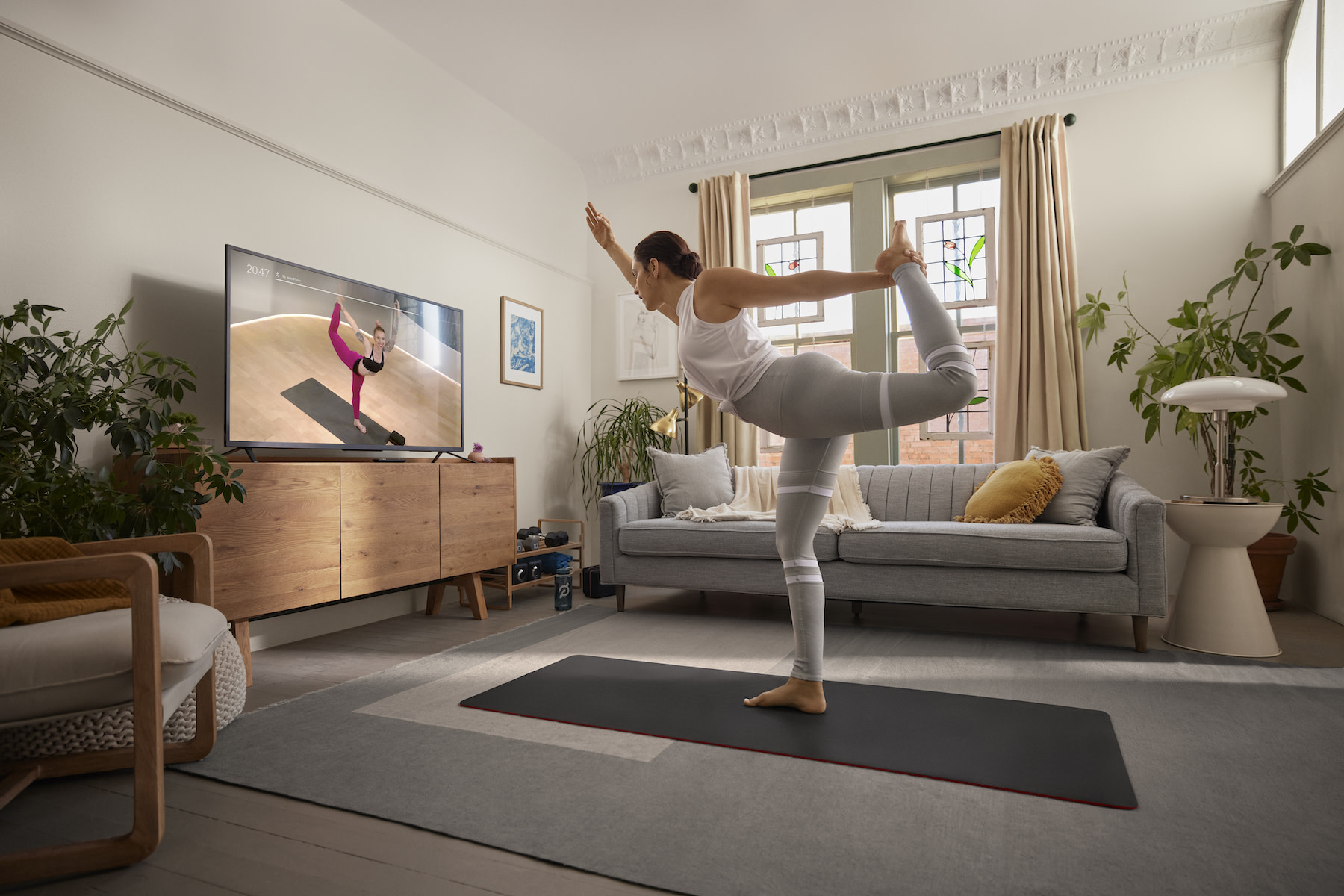
Pilates vs. Yoga: Which One Is Better for You? (Spoiler Alert: It Depends)
A Pilates and yoga expert explains the differences and benefits of these low-impact workouts.
By Michele Ross•
What Is Pilates?
The Benefits of Pilates
What Is Yoga?
Benefits of Yoga
The Main Differences Between Pilates and Yoga
Pilates vs. Yoga: Key Similarities
Pilates vs. Yoga: Which Is Better Based On Your Goals?
The Takeaway
Many of us gravitate to a particular type of exercise. Personally, I’m drawn to low-impact forms of mindful movement, so it’s no surprise that yoga and Pilates have long been my favorite workouts. It’s true that the two have a lot in common. However, they’re not one-and-the same. In this guide to Pilates vs. yoga, we’ll unpack the basics and benefits of each, as well as their key similarities and differences. Plus how to decide which modality is ideal for your goals and personal needs.
Discover more ways to reach your goals with Peloton
What Is Pilates?
Pilates is a form of strength training and conditioning that uses precise movements to lengthen, strengthen, and balance the body. While many Pilates exercises and techniques work the full body, a major focus is on the “Pilates powerhouse,” aka the core. Traditionally, Pilates is performed on a mat and may also involve apparatus work (think: the Reformer, Cadillac, and other equipment).
Founded by German physical trainer and inventor Joseph Pilates in the 1920s, his namesake form of fitness is famed for its emphasis on core strength, flexibility, and alignment—but its foundations encompass much more than that. The fitness pioneer based the practice on three core principles: breath, whole-body health, and whole-body commitment. In this context, “whole-body” encompasses the mental, physical, and spiritual realms.
More broadly, these principles involve the precise fundamentals of “breath, concentration, control, center, precision and flow,” shares Peloton instructor Aditi Shah. “Peloton Pilates classes (and many others) vary from his original, classical mat Pilates routine, but are rooted in the same movements and principles.”
The Benefits of Pilates
“Pilates is an incredible practice to create greater proprioception and gain greater strength, mobility, and flexibility while working from your core,” Aditi explains. “Pilates is precise and organized in its movement patterns, which helps us to create healthy ranges of motion within our body.”
Physical Benefits of Pilates
Research-backed physical benefits of Pilates include but aren’t limited to:
Sculpting and toning via strength training
Improved posture via spinal alignment and core strength
Relief from low back pain, menstrual pain, and even pain while giving labor
Mental Health Benefits of Pilates
Pilates boasts perks for mental health and agility, as well, such as:
What Is Yoga?
In the West, yoga is most commonly associated with the physical practice of asanas (aka postures). However, physical fitness is actually just a single component of the ancient Indian discipline. “First and foremost, yoga is a philosophical practice with many different lineages,” Aditi explains. “The movement portion, or asana practice, is a tiny element of the myriad of different ways we can engage with yoga.”
In fact, per the Yoga Sutras of Patanjali—the foundational text on the theory and practice of yoga—yoga is comprised of 8 limbs, or parts. Asana is third on the list, preceded by moral restraints and positive duties. Breathing techniques come after asana, while the final 4 limbs involve different forms of meditation, culminating in the final state of samadhi (aka bliss or enlightenment).
As far as the physical practice goes, it’s also worth noting that there are countless types of yoga to choose from. Such examples include:
Hatha: A more traditional and slower-paced flow.
Vinyasa: A flow that links breath to movement in a fluid sequence of poses.
Ashtanga: An energetic, challenging style of yoga composed of 6 set sequences.
Restorative: A slower-paced class focusing on release, rest, and relaxation.
Conditioning: These classes use light weights to increase resistance and build strength.
Yin: A type of yoga that involves long holds to target connective tissues, release tightness, and unblock negative energy.
Benefits of Yoga
Yoga can have powerful therapeutic effects for your mind and body alike. “Yoga can be used in so many ways,” Aditi says. “[From] a philosophical point of view, yoga can fundamentally change how we relate to ourselves and life, and therefore has innumerable benefits for body, mind, and the whole being.”
Physical Benefits of Yoga
Per a 2011 review in the International Journal of Yoga, physical benefits of yoga include:
Enhanced muscular strength
Greater flexibility
Improvements in respiratory and cardiovascular function
Better sleep
Relief from chronic pain
Mental Health Benefits of Yoga
According to the same review, some of the most significant mental health benefits of yoga include:
Reduced stress, anxiety, and depression
A stronger sense of well-being
A higher quality of life
Mind-Body Benefits of Yoga
Some benefits will vary based on the type of yoga you practice, your consistency, and similar factors. The specific poses and breathing exercises you perform will also have a major influence on how you feel in your mind and body. For instance, heart-openers are energizing and uplifting. As such, they can be helpful if you’re dealing with the likes of fatigue, poor posture—or even if you want to invite more joy or compassion into your life. Forward folds, on the other hand, are soothing and stress-relieving; they allow you to find ease within the pose and thus within yourself. They also lengthen the spine and stretch the hamstrings, among other body part-specific benefits.
Rest assured that there are many perks to be had no matter which yoga adventure you choose. So long as your practice honors your own needs, there’s really no wrong way to go.
The Main Differences Between Pilates and Yoga
While Pilates and yoga share quite a few benefits and can certainly complement each other—as well as other forms of physical fitness like cardio, weight lifting, etc.—they’re not interchangeable. For starters, they differ across a few foundational aspects.
“Yoga and Pilates have different origins and serve different purposes,” Aditi notes. “Asana is one small part of numerous practices encompassed in the philosophy of yoga, and Pilates is primarily a movement-based practice focused on health and wellness.”
Moreover, yoga is an ancient Indian discipline that leans heavily into spirituality. It’s also a way of living within yourself and alongside others—i.e., it extends far beyond what you do on your mat. Pilates is a modern form of movement that invites you to tap into mental and spiritual well-being. That said, it’s an exercise first and foremost.
Pilates vs. Yoga: Key Similarities
Again, Pilates and yoga have a lot in common. Many people who practice or even teach one may naturally gravitate toward the other.
They Encourage Mindful Movement
Practitioners of both modalities must stay present and focus on precise body parts within each pose, whether that involves grounding, activating, and/or releasing. Moreover, at their (pardon the pun) core, Pilates and yoga emphasize the importance of breathing. Proper breathwork won’t only allow you to perform and ease into each pose properly with grace, but also help promote the meditative and mental health benefits associated with each modality.
Paired together, mindfulness and breathing comprise a powerful duo that can amplify your practice in many ways. For instance, this could look like:
Pilates hundreds: You may be cued to draw the navel to the spine—all the while alternating equal grouped counts of sharp, rapid inhales and exhales—in order to engage and stabilize your core
Poorna Salabhasana (aka full locust pose): You may be instructed to keep your hips grounded into the mat as you arch your back and lift your head, arms, chest, torso, and legs—all the while maintaining an 80/20 breath (80 percent inhale, 20 percent exhale)—and not clenching your jaw or buttocks
They’re Low Impact and High Reward
Yoga and Pilates count as low-impact exercise, making both safe and accessible for all bodies across all ages. They each have varying degrees of intensity, which will depend on the type of poses or classes you choose. For instance, low-intensity options include rehabilitative Pilates and restorative yoga. Both are light on vigor without sacrificing benefits like enhanced mobility, a better mood, and an improved sense of well-being. Want to rev up the intensity? You can always opt for an advanced Pilates class, power yoga, and the like to challenge yourself and build strength. (Tip: There’s something for everyone on the Peloton App.)
They Create a Domino Effect to Promote Health and Well-Being
Finally, per a 2021 study published in the International Journal of Environmental Research and Public Health, both practices can be seen as gifts that keep on giving. Across 90 adult participants, those who practiced Pilates or yoga (versus neither) over 8 weeks:
Showed higher engagement in health-promoting behaviors
Reported significant improvements in subjective health status
In conclusion, the researchers noted that both Pilates and yoga have the power to “set a positive reinforcement cycle in motion.” Best of all, these shared benefits can extend across body, mind, and spirit alike.
Pilates vs. Yoga: Which Is Better Based On Your Goals?
Pilates and yoga have many benefits and are surely worth trying out for yourself. Yet sometimes, one may be better suited for your goals and personal needs.
For instance, it could be worth incorporating Pilates into your fitness routine if you want to:
Focus on strength and flexibility via resistance training
Focus on strengthening your core
Target small muscle groups that may not get enough attention or activation during other workouts
Maintain constant movement during your workout
Varying types of yoga classes may be up your alley if you prefer to:
Have an active recovery day
Get a targeted stretch
Focus on grounding and calming (namely via restorative yoga)
Stretch connective tissue (namely via Yin yoga)
Integrate a meditative or spiritual component into your wellness regimen
These points considered, Aditi points out that all bodies are different. What works well for one person might not for the next, so experimentation and personalization are key. This is especially important to consider if you’re new to either modality. “It's a good idea to add one thing at a time and see how you respond so you aren't overexerting yourself,” she shares. “The only exception to this is restorative yoga, which is very supportive and safe to add into any routine.”
The Takeaway
In truth, the face-off between Pilates vs. yoga isn’t really a battle at all. Neither is inherently superior to the other, and the two practices withstand the test of time for overlapping reasons. In short, both utilize breathing, mindfulness, and low-impact moves to yield benefits like greater strength, flexibility, and mobility —not to mention have the power to improve your mental and emotional health.
At the same time, they have vastly different origins and hail from different corners of the world. Yoga is an ancient Indian philosophical practice and way of living, of which exercise is only a small component. Meanwhile, Pilates was invented only a century ago; it uses specific moves (and sometimes equipment) to bring the body—and thus the mind and spirit—back to balance.
There are many benefits associated with both practices, some of which may be more appealing based on your specific goals or health concerns. Nonetheless, Pilates and yoga are both highly modifiable and are accessible for different bodies, interests, and needs. In time, you just might find that one, or even both, will perfectly complement your existing workout flow and greater wellness routine.
This content is for informational and educational purposes only and does not constitute individualized advice. It is not intended to replace professional medical evaluation, diagnosis, or treatment. Seek the advice of your physician for questions you may have regarding your health or a medical condition. If you are having a medical emergency, call your physician or 911 immediately.
Level up your inbox.
Subscribe for a weekly dose of fitness, plus the latest promos, launches, and events.
By providing your email address, you agree to receive marketing communications from Peloton.
For more about how we use your information, see our Privacy Policy.


















